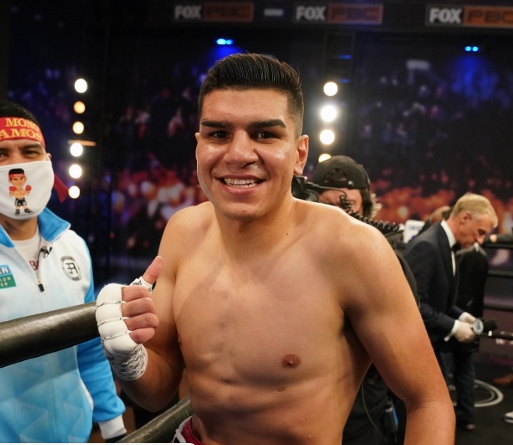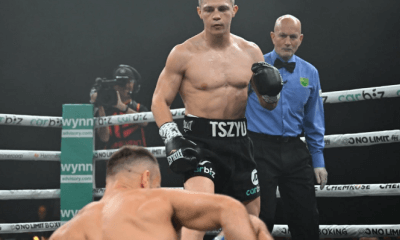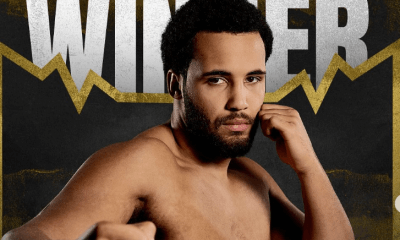Featured Articles
Arizona Whiz Kid Jesus Ramos has a Big Upside and an interesting Back Story

If all the pieces come together, the PBC card on Feb. 5 at Mandalay Bay will have a distinct Arizona flavor. Welterweight Abel Ramos, the pride of Casa Grande, is in the co-feature against Josesito Lopez, a two-time world title challenger. Phoenix featherweights Keenan Carbajal and Carlos Castro step up in class with Leo Santa Cruz (Carbajal) and Luis Nery (Castro) providing the opposition. And Abel Ramos’s nephew, fast rising super welterweight Jesus Ramos, takes on upset-maker Vladimir Hernandez.
Abel Ramos followed his split-decision loss to Yordenis Ugas with his career-best performance, a six-round demolition of Omar Figueroa. If he gets past the veteran Lopez, as expected, he will likely fight the winner of the featured attraction which sees Keith Thurman returning to the ring after a 31-month absence to meet Mario Barrios. A rematch with new WBA champion Ugas, who dethroned Manny Pacquiao, is also a possibility. However, it is the younger Ramos, 20-year-old Jesus Ramos, who is attracting the most buzz. Currently 17-0 (14 KOs), he has the look of a future star.
Boxing is family tradition in the Ramos households in Casa Grande, a fast-growing city of 55,000 that sits 45 miles south of Phoenix and 70 miles north of Tucson. Jesus’s father boxed as an amateur as did Abel’s father and his two brothers. In recent years, the family has become more identified with boxing with the opening of the Ramos Boxing Academy, a gym that sits in a large shopping mall known as the Promenade. It serves people aged seven and up, both active and aspiring boxers and folks that just want to stay physically fit.
Jesus Ramos and his three younger siblings were born in Casa Grande to immigrants from the Mexican state of Sinaloa. Jesus’s father had an assortment of jobs, including that of a welder and a mailman, before developments allowed him to pursue his passion as a full-time boxing coach. When he is at home, Jesus gets to practice at the academy in a regulation-size ring as opposed to the miniature ring in the family garage that was his pitch when he was first starting out.
His parents gave him his nickname “Mono.” It’s a word with many meanings when translated to English, but here the reference is to an action figure of a mischievous little boy. Every pay-per-fight was an opportunity for a family get-together and the young Jesus soaked it all in, “not just the fight,” he says, “but the ring walk, the music; every little detail.” His favorite fighters were Ricardo “Finito” Lopez and Marco Antonio Barrera, both Future Hall of Famers, and he aspired to follow in their footsteps.
Jesus turned pro at age 17 in Mexico. In recent years, that’s become a common pathway for precocious West Coast boxers who are too young to compete as professionals in the United States because of age requirements. Devin Haney and David Benavidez come quickly to mind among other U.S.-born boxers that started their pro careers as teenagers in Mexico.
Jesus Ramos had his first eight fights in Mexico in places like Cheer’s Bar, a raucous, two-story, late-night dance hall in Tijuana. Judging by his motley competition – none of his opponents lasted beyond the second round – he would have been better served by staying an amateur, but he disagrees, saying it was good preparation for a career in a sport where the unexpected is normal. He laughs when he recalls the time when he found upon entering the ring that his opponent was a different guy than the fellow he faced-off against at the weigh-in.
Precocious boxers tend to quit school early, or be home-schooled if they wish to stay on track to earn a diploma. But Jesus managed to attend class with his chums including a semester at the local junior college while juggling school with his burgeoning boxing career. “My parents [his mom is a pre-school teacher] didn’t believe in home schooling,” he says. “They wanted me to have a normal life.”
This past October, Jesus Ramos was honored at his high school’s homecoming football game. He was on the field for the ceremonial coin toss and gave a pre-game pep talk to the team. Vista Grande High School is a fairly new school without much of a sports tradition, but on that Friday afternoon they turned away visiting Yuma High by a 28-20 score.
Perhaps Jesus has a future as a motivational speaker, but he has other thoughts about his life after boxing. With his ring earnings he bought a 26-foot delivery truck (no, he doesn’t plan to drive it), with an eye toward branching out into the trucking business. Down the road, he envisions building a gym in Flagstaff, Arizona, that would be dedicated wholly to boxing.
Casa Grande is on the Sonoran Desert. During June, July, and August, the high temperature seldom dips below 100 degrees. Flagstaff, surrounded by mountains, is in northern Arizona and weather-wise it might just as well be in Montana. In the winter months, it can get brutally cold.
When Jesus Ramos looks at Flagstaff, he is reminded of Colorado Springs, Colorado, where he spent many weeks while serving as a sparring partner for Terence Crawford. Both cities are more than a mile above sea level and the altitude is considered ideal for athletes, especially those that participate in sports that place a premium on stamina.
Flagstaff is on Ramos’s radar screen for another reason. It is home to Northern Arizona University where his sister Briana is a freshman. It’s all about family with the Ramos’s and Briana is undoubtedly the only person in the NIU girls’ dormitory that can claim to have once worked in the corner of a professional boxer.
Briana was pressed into service on the day after Christmas of 2020 at the Shrine Expo Center in Los Angeles when other members of the Ramos family were spending the holidays with kinfolk in Sinaloa. This was a so-called “bubble show,” a show held without fans because of the pandemic with tight restrictions as to the number of people each combatant was allowed to bring with him. Briana was put in charge of the stool. “She was more nervous than me,” recalls Jesus who made it easy on his little sister by bringing the fight to a premature conclusion. His opponent was pulled out after four rounds.
Jesus and his uncle Abel, 10 years older than Jesus, have been preparing for their Feb. 5 assignments in Las Vegas. With them is a quiet young man, Abelardo Loya, a registered nurse from Chihuahua, who has been conscripted as a massage therapist. And how did he come to be part of Team Ramos? “He’s Abel’s girlfriend’s cousin,” explains Jesus.
Jesus “Mono” Ramos, it says here, has a big upside. And as he advances, Casa Grande’s first family of boxing will attract more notice, perhaps eventually rivaling Southern California’s fighting Garcias’ (Eduardo, Robert, and Mikey) as a noted family dynasty.
Check out more boxing news on video at the Boxing Channel
To comment on this story in the Fight Forum CLICK HERE
-

 Featured Articles4 weeks ago
Featured Articles4 weeks agoThe Hauser Report: Zayas-Garcia, Pacquiao, Usyk, and the NYSAC
-

 Featured Articles3 weeks ago
Featured Articles3 weeks agoOscar Duarte and Regis Prograis Prevail on an Action-Packed Fight Card in Chicago
-

 Featured Articles2 weeks ago
Featured Articles2 weeks agoThe Hauser Report: Cinematic and Literary Notes
-

 Book Review2 weeks ago
Book Review2 weeks agoMark Kriegel’s New Book About Mike Tyson is a Must-Read
-

 Featured Articles4 weeks ago
Featured Articles4 weeks agoRemembering Dwight Muhammad Qawi (1953-2025) and his Triumphant Return to Prison
-

 Featured Articles7 days ago
Featured Articles7 days agoMoses Itauma Continues his Rapid Rise; Steamrolls Dillian Whyte in Riyadh
-

 Featured Articles3 weeks ago
Featured Articles3 weeks agoRahaman Ali (1943-2025)
-

 Featured Articles3 weeks ago
Featured Articles3 weeks agoTop Rank Boxing is in Limbo, but that Hasn’t Benched Robert Garcia’s Up-and-Comers



















